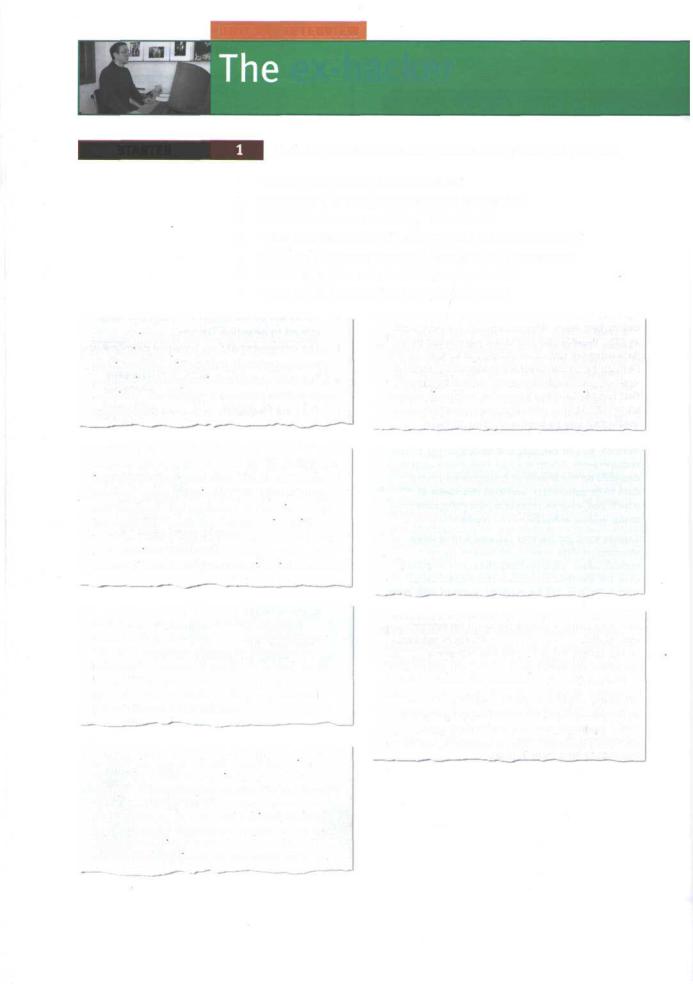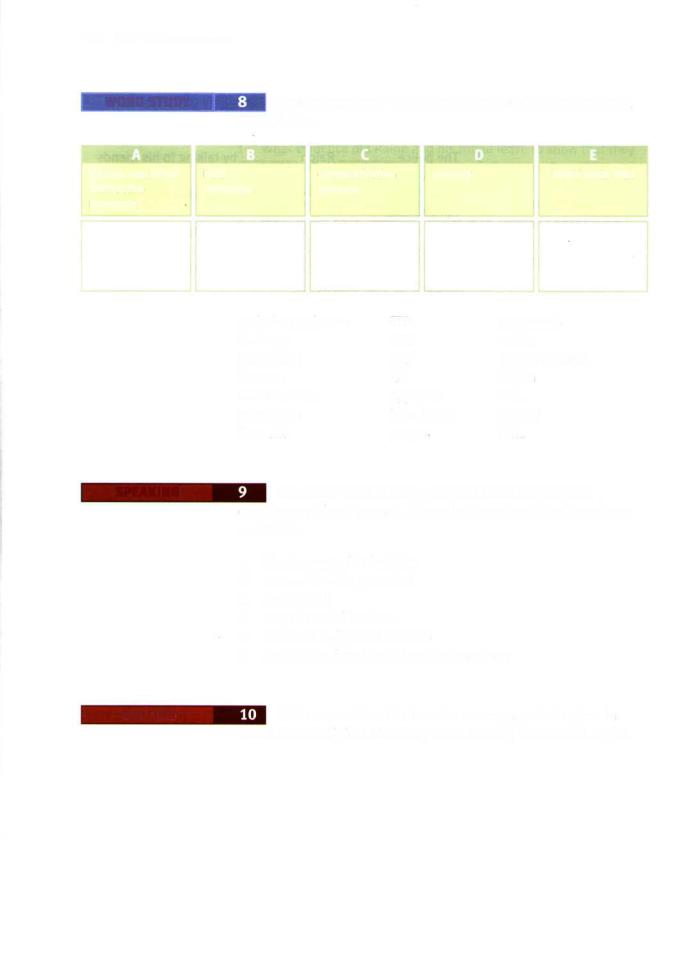
Oxford_English_for_Information_Technology / Text / unit20
.pdf
UNIT 20 INTERVIEW
ex-hacker
STARTER |
Find the answers to these questions as quickly as you can. |
1Which group hacked into Hotmail?
2Who was 'The Analyser' and what did he do?
3Which hacker was sent to jail for fraud?
4What was the effect of the 1996 raid on Scotland Yard?
5Which of the cases reported here involved teenagers?
6What did hackers do to the Yahoo! website?
7What crime was Raphael Gray accused of?
Kevin Mitnick is the hackers' hero. His latest spell in jail was a 46-month sentence for fraud relating to breaking into the systems of several multinational corporations. He was released on condition that he did not have any contact with a computer.
In March 2000, a Welsh teenager allegedly stole information from more than 26,000 credit card accounts across Britain, the US, Japan, Canada and Thailand, and published the details on the Internet. FBI agents and British police raided the home of Raphael Gray,18, and arrested him and his friend. He has been charged with 10 counts of downloading unauthorised information.
In 1998Washington revealed thatan Israeli hacker called 'The Analyser' was responsible for 'the most organised attempt to penetrate the Pentagon's computer systems'. He turned out to be Ehud Tenenbaum, 18, who had planted a list of his own passwords in the Pentagon system and passed them to other hackers.
In 1997 the son of a fraud squad detective walked free from a court in London after charges of breaching the security of the US air force were dropped. Three years earlier Mathew Bevan, then 19, and a friend, Richard Pryce, 16, used the Internet to gain access to several US military bases. Pryce was fined £1,200 after admitting several other offences.
Hotmail, Microsoft's free email service, was hacked into last September, exposing the correspondence of more than 40m users. A group calling itself Hackers Unite posted a Web address with details of how to access any Hotmail account. The service was shut down for five hours.
The UK Department ofTrade and Industry has twice been prey to hackers, once in 1996 and again in 2000 when a DTI computer was programmed to reroute email. The Home Office investigated nine cases of hacking last year, one of which was the leaking of a report on a murder. In August 1996 hackers ran up a £lm phone bill for Scotland Yard but did not access flies.
In ] 997 hackers got into the Yahoo! website, replacing the homepage with a ransom note demanding the release of their hero, Kevin Mitnick. Unless the demand was met, the note said, a virus would be released in all Yahoo!'s computers. The company dismissed the threat as a hoax, but the 'Free Kevin' slogan continued to appear on other hijacked sites.

LISTENING |
Think about these questions before you listen. |
1 |
How could you hack into a system? |
2 |
How could you stop people hacking into a system? |
Mow listen to Part 1 of the recording to check your answers to Task 2 and to find the answers to these questions:
1What was Ralph arrested for?
2What does he do now?
3Why does he say people are too trusting?
4What passwords does he suggest for trying to get into a system?
5What does a firewall do?
6What is the advantage of a callback system?
7To prevent hacking, what sort of passwords should you avoid?
8What do event logs show?
Now listen to Part 2 of the recording and find the answers to these questions:
1How did Ralph start thinking about computer security?
2How did he find the most senior ID in the American company's system?
3According to Ralph, why do people hack?
4Why did he and his friend hack?
5How did the police find him?
6Why does he say companies should use his services?
7Do hackers know each other?
8What's the difference between Hollywood hackers and the real world?
9How risky is credit card use on the Internet?
10What advice does he give for people intending to use credit cards over the Internet?

142 UNIT 20 The ex-hacker
Now listen to both parts again to find the answers to these questions:
1What evidence did Ralph and his friend leave to show that they had hacked into the American company's system?
2What is a 'white hat' hacker?
3What two ways does Ralph give for hacking into a system?
4What terms does Ralph use to describe someone obsessed by computers?
5How does he maintain contact with the policeman who arrested him?
6How does he describe his lack of enthusiasm for the Hollywood hacker?
7What does he mean by 'It's the retailers who get done'?
8What's the problem with using smart cards for Internet purchases?
LANGUAGE WORK
A phrasal verb is a verb + preposition combination. For example, look up, take down, turn over. Phrasal verbs are common in informal, spoken English. Sometimes they have a more formal one word equivalent, for example, work out = determine.
Often phrasal verbs have two meanings.
One we can work out from the meaning of the two words separately:
She looked up at the roof.
A special meaning which does not easily relate to the separate meanings of the words:
She looked up a word in the dictionary.
Study these phrasal verbs from the Task 1 texts and the recording:
break into |
grow up |
throw away |
get into |
phone up |
log on |
hack into |
run up |
find out |
go about |
keep at |
track down |
set about |
shut down |
hand over |
keep ahead |
|
|
Now complete each blank with the appropriate phrasal verb in the correct form. In some cases, more than one answer is possible.

144 UNIT 20 The ex-hacker
WORD STUDY |
Semantic groups |
Group these terms into the five headings, |
|||
|
A to E, below. |
|
|
|
|
Viruses and other |
Data |
Communication |
Internet |
World Wide Web |
|
destructive |
protection |
systems |
|
|
|
programs |
|
|
|
|
|
|
. |
|
|
|
|
|
anti-virus |
software |
FTP |
|
passwords |
|
backups |
|
GPS |
|
router |
|
bandwidth |
|
IRC |
|
trigger routine |
|
browser |
|
ISP |
|
Trojan |
|
domain name |
hyperlink |
URL |
||
|
encryption |
logic |
bomb |
Usenet |
|
|
firewalls |
|
pagers |
XML |
|
SPEAKING |
Role play Work in pairs. Together make up your own |
||||
questions on these prompts. Then play the parts of the interviewer and Ralph.
1first interested in hacking
2reason for being arrested
3present job
4ways to avoid hackers
5views on Hollywood hackers
6safe ways of paying for Internet shopping
WRITING |
Write a news item like the short newspaper texts given in |
|
Task 1 about Ralph or about any other hacking case known to you. |

UNIT 20 The ex-hacker |
145 |
Study this extract from a virus information database. Then make a flowchart to show each step in the method of infection for this virus. Steps 1 and 2 are done for you.
Step 1 An infected .EXE file arrives as an email attachment. Step 2 The infected .EXE file is opened.
Virusname W32/Magistr.@MM
Risk assessment Medium
Date discovered 12/3/01
Origin Sweden
Length Varies, adds at least 24KB
Type virus Sub-type worm
Method of infection
This is a combination of a files infector virus and an email worm.
The virus arrives as an .EXE file with varying filenames. When you execute the attachment, your machine is infected and in turn is used to spread the virus.
When first run, the virus may copy one .EXE file in the Windows or Windows System directory using the same name but with the final character of the filename decreased by a factor of 1. For example, EHGEDI57.EXE willbecome EHGEDI56.EXE, TCONTRACT.EXE will become TCONTRACS.EXE.
This copy is then infected and a WIN.INI entry, or registry run key value may be created, to execute the infected file when the system starts up.
This copied executable infects other 32 bit .EXE files in the Windows directory and subdirectories, when run.
Five minutes after the file is opened, the email worm attempts a mailing routine. It creates a .DAT file hidden somewhere on the hard disk. This contains strings of the files used to grab email addresses from address books and mailboxes. The .DAT file name will be named after the machine name in a coded fashion. For example, y becomes a, x becomes b. Numbers are not changed. The worm uses mass mailing techniques to send itself to these addresses. The subject headings, text and attachments will vary. The text is taken from other files on the victim's computer.
This worm may also alter the REPLY-TO email address when mailing itself to others. One letter of the address will be changed. This makes it difficult to warn the victim that their machine is infecting others as the message will be returned to sender.

UNIT 20 The ex-hacker 143
1Hackers try to passwords so they can penetrate a system.
passwords so they can penetrate a system.
2Don't your password to anyone who asks for it.
your password to anyone who asks for it.
3The police Ralph
Ralph by talking to his friends and acquaintances.
by talking to his friends and acquaintances.
4Some hackers systems to get commercially valuable information.
systems to get commercially valuable information.
5When you to a network, you have to provide an ID.
to a network, you have to provide an ID.
6How do you hacking into a system?
hacking into a system?
7Hackers may pretending to be from your company, and ask for your password.
pretending to be from your company, and ask for your password.
8Never your credit card receipts where someone can find them.
your credit card receipts where someone can find them.
9Ralph was a hacker as a teenager but he's now and become more responsible.
now and become more responsible.
10 a system is strictly illegal nowadays.
a system is strictly illegal nowadays.
11 It's a constant race to of the hackers.
of the hackers.
Replace the verb in italics with a phrasal verb of similar meaning. All the phrasal verbs required have been used in this book.
1Don't discard your credit card receipts; they could help fraudsters.
2Trying to penetrate computer systems is against the law.
3The typical hacker is a young person who has not matured yet.
4The best way to begin hacking into a system is to try to get hold of a password.
5If someone telephones you and asks for your password, don't provide it.
6Hackers closed Hotmail for five hours.
7Hackers accumulated a telephone bill of £lm for Scotland Yard.
8The difficult thing was to determine how the website would look.
9So you won't forget, record the ID number the support technician gives you.
10Examine the manufacturers' websites before you phone for help.

144 UNIT 20 The ex-hacker
WORD STUDY |
I |
Semantic groups Group these terms into the five headings, |
||
|
A to E, below. |
|
|
|
Viruses and other |
Data |
Communication |
Internet |
World Wide Web |
destructive |
protection |
systems |
|
|
programs |
|
|
|
|
|
anti-virus software |
FTP |
passwords |
|
|
backups |
|
GPS |
router |
|
bandwidth |
|
IRC |
trigger routine |
|
browser |
|
ISP |
Trojan |
|
domain name |
|
hyperlink |
URL |
|
encryption |
|
logic bomb |
Usenet |
|
firewalls |
|
pagers |
XML |
SPEAKING |
Role play |
Work in pairs. Together make up your own |
||
questions on these prompts. Then play the parts of the interviewer and Ralph.
1first interested in hacking
2reason for being arrested
3present job
4ways to avoid hackers
5views on Hollywood hackers
6safe ways of paying for Internet shopping
WRITING |
Write a news item like the short newspaper texts given in |
|
Task 1 about Ralph or about any other hacking case known to you. |

UNIT 20 The ex-hacker 145
Study this extract from a virus information database. Then make a flowchart to show each step in the method of infection for this virus. Steps 1 and 2 are done for you.
Step 1 An infected .EXE file arrives as an email attachment. Step 2 The infected .EXE file is opened.
Virusname W32/Magistr.@MM
Risk assessment Medium
Date discovered 12/3/01
Origin Sweden
Length Varies, adds at least 24KB
Type virus Sub-type worm
Method of infection
This is a combination of a files infector virus and an email worm.
The virus arrives as an .EXE file with varying filenames. When you execute the attachment, your machine is infected and in turn is used to spread the virus.
When first run, the virus may copy one .EXE file in the Windows or Windows System directory using the same name but with the final character of the filename decreased by a factor of 1. For example, EHGEDI57.EXE will become EHGEDI56.EXE, TCONTRACT.EXE will become TCONTRACS.EXE.
This copy is then infected and a WIN.INI entry, or registry run key value may be created, to execute the infected file when the system starts up.
This copied executable infects other 32 bit .EXE files in the Windows directory and subdirectories, when run.
Five minutes after the file is opened, the email worm attempts a mailing routine. It creates a .DAT file hidden somewhere on the hard disk. This contains strings of the files used to grab email addresses from address books and mailboxes. The .DAT file name will be named after the machine name in a coded fashion. For example, y becomes a, x becomes b. Numbers are not changed. The worm uses mass mailing techniques to send itself to these addresses. The subject headings, text and attachments will vary. The text is taken from other files on the victim's computer.
This worm may also alter the REPLY-TO email address when mailing itself to others. One letter of the address will be changed. This makes it difficult to warn the victim that their machine is infecting others as the message will be returned to sender.
